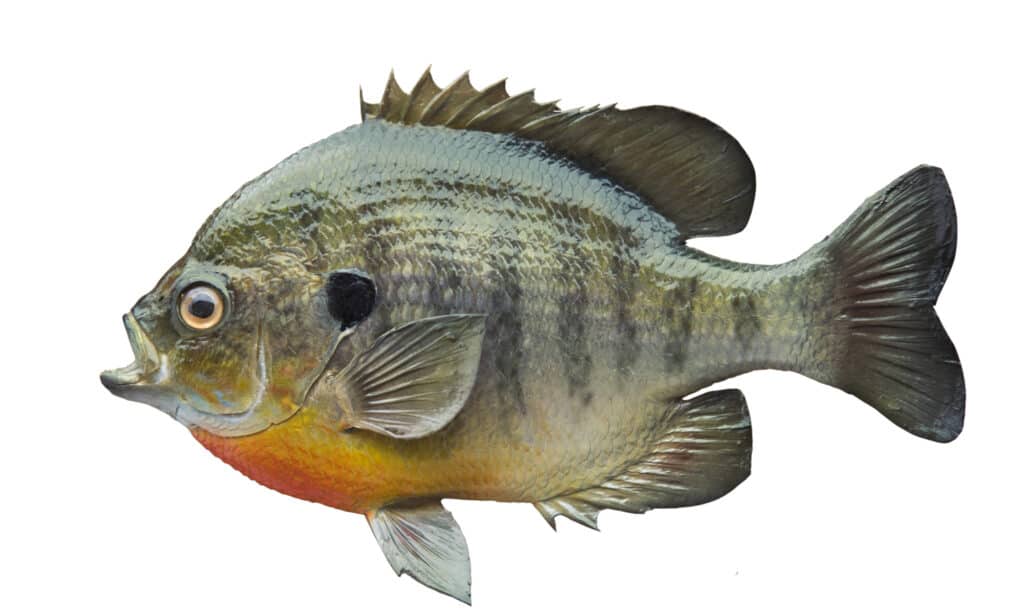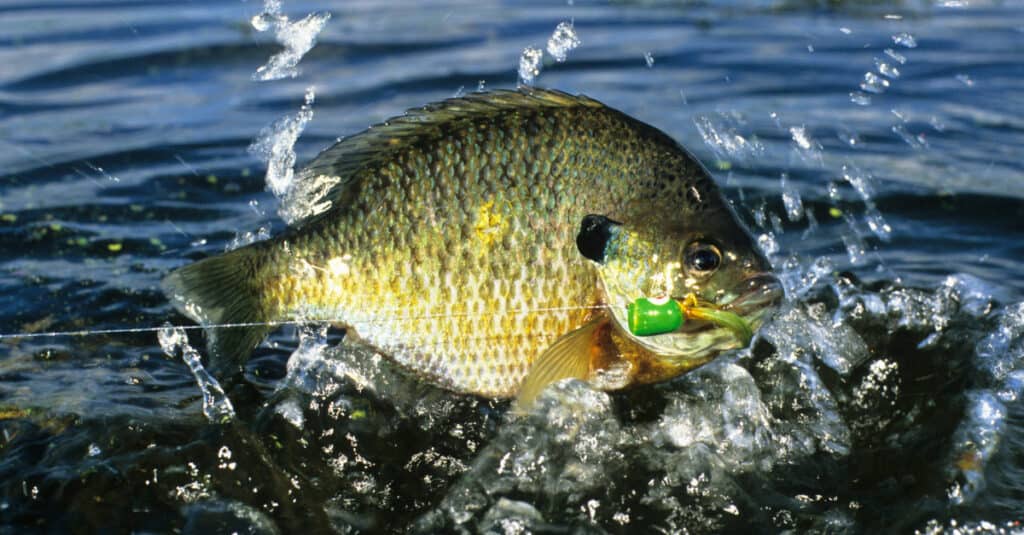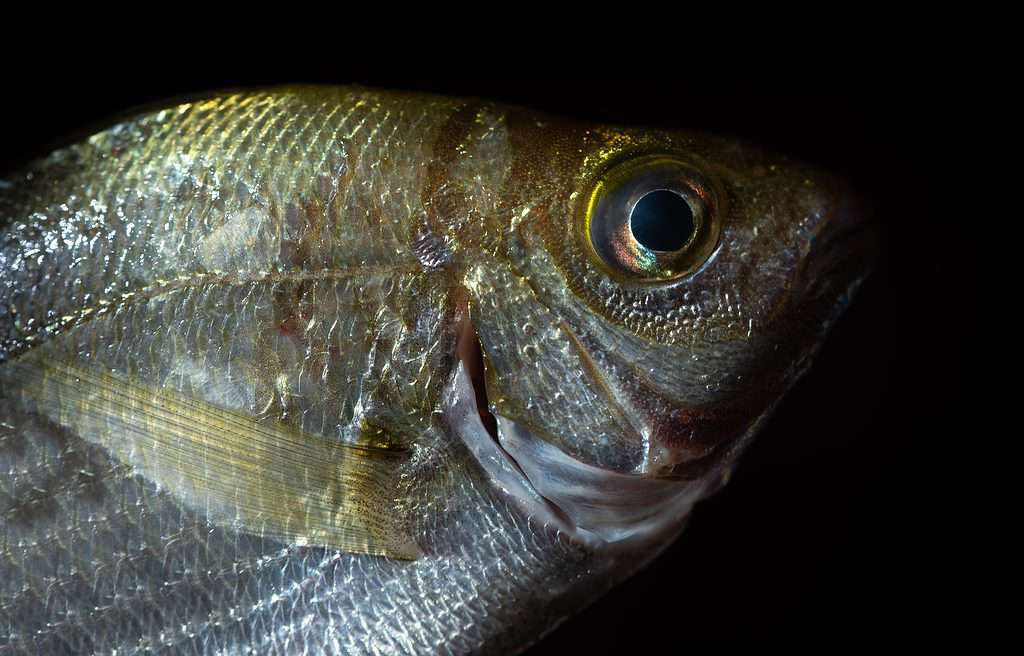Thousands of pounds of bluegills make it onto dinner plates throughout the United States, often paired with parmesan cheese. These are highly nutritious fish packed with protein and zero carbs for both humans and other fish. Trout and bass also feed on these fish, which is why bluegill-shaped swimbait is used regularly on fishing trips.

©iStock.com/mpwoodib
What are Bluegills?
Bluegills are part of the sunfish family. They call freshwater lakes and streams home and typically weigh about one to 2.6 pounds. On average, they grow around seven to fifteen inches long and their colorations vary from browns and yellows to blues and blacks and greens and oranges. They feast on small crustaceans and insects, and they usually swing alongside one another in schools of 10 to 20 fish.
Bluegills are often referred to as panfish for no other reason than their bodies fit perfectly into the shape of a pan for frying! Their bodies are round and thick with tiny mouths. Their coloration changes, especially during breeding season when a male bluegill’s scales boast bright orange around the belly area.
To defend themselves against predators like humans, trout, raccoons, and great blue herons, bluegills employ two main defenses. The first is to hide under debris or underwater logs. The other, more impressive defense is their incredible swimming speed. Not only do they move fast, but they also change directions rapidly, even swimming backward at times.

©Dan Thornberg/Shutterstock.com
Bluegill Fishing Basics
Bluegill fishing is a beginner-friendly activity, providing plenty of action and bounty for a long day’s work. The easiest time to catch bluegill is during the spawn when they nest. They strike at any approaching threat, which makes them more visible and vulnerable. Their vulnerability and hypervigilance work in their favor, however. They spook with ease, making them more elusive.
Quiet-presenting baits are your best bet to prevent flushing the fish from their nesting place. It’s best to make your way toward the borders of a spawning colony, using artificial flies (woolly buggers or woolly worms) while casting your fly rod. If you prefer using live bait, go for worms, crickets, or grasshoppers. Keep in mind how tiny a bluegill’s mouth is as well — your best bet is a number six hook.

©iStock.com/stammphoto
Record-Breaking Catch in Ketona Lakes, Alabama
The biggest bluegill ever caught was in Ketona Lakes, Alabama. The year was 1950. T.S. Hudson went over to the water’s edge one day in April using a long cane pole and a few red worms. The bluegill weighed an awe-inspiring four pounds and 12 ounces and measured 15 inches long. Its recorded girth was 18.25 inches. Hudson broke the world record only three years after Coke McKenzie, a local, broke the record with his four-pound, 10 ounces bluegill catch.
Ketona Lakes started off as open-pit mines. In 1932, operations ceased in the area after a blast opened a massive underground spring. Ketona Lakes then became popular swimming holes for all the locals. It also became a favorite fishing spot for locals like McKenzie and Hudson, who managed to break world records at the same site.

Why is the fishing so good at Ketona Lakes?
Biologists were puzzled by these events and eventually got permission to study the phenomenon. Some speculated there was a genetic influence for these large bluegills but eventually, they realized there were a couple of factors that impacted the size of bluegills at Ketona Lakes. For one, there was limestone present, which provided the fish with enhanced nutrition. This was one factor that impacted their growth rates.
Additionally, the lakes had precipitous sides, which made spawning difficult for bluegills. Limited space for nesting means bluegills didn’t reproduce as much as usual, creating a bit of crowd control in the lakes. Along with limited space, there was a heavy bass presence, which again prevented bluegill overcrowding.
Bluegills that managed to survive in the Ketona Lakes had an abundance of food alongside enhanced nutrients to grow as much as they did. They also had the space for growth and since there was restricted fishing pressure, they had the time to keep growing as well. Ketona Lakes was a private lake, after all.
Not only did all of these factors combine to encourage the growth of bluegills, but with so many favorable happenings, bluegills also aged surprisingly well. On average, bluegills are thought to reach about six years old but being that they’re such a popular fish for anglers, they may only reach about four years old. McKenzie’s catch was studied by Auburn University. Their determination was that the bluegill was about nine years old when McKenzie caught it.
Ketona Lakes Today
Ketona Lakes may still house some of the largest and oldest bluegills, but it is not open to the public. The owners have kept the space private, preventing access for curious anglers. Unless there is a change that inspires the owners to open access or to sell their property, bluegills may continue growing to remarkable sizes without anyone ever knowing.
Up Next
The post Discover the Biggest Bluegill Ever Caught (And the Lake It Was Pulled) appeared first on AZ Animals.
from Animal News, Facts, Rankings, and More! - AZ Animals https://ift.tt/kTVwa2j